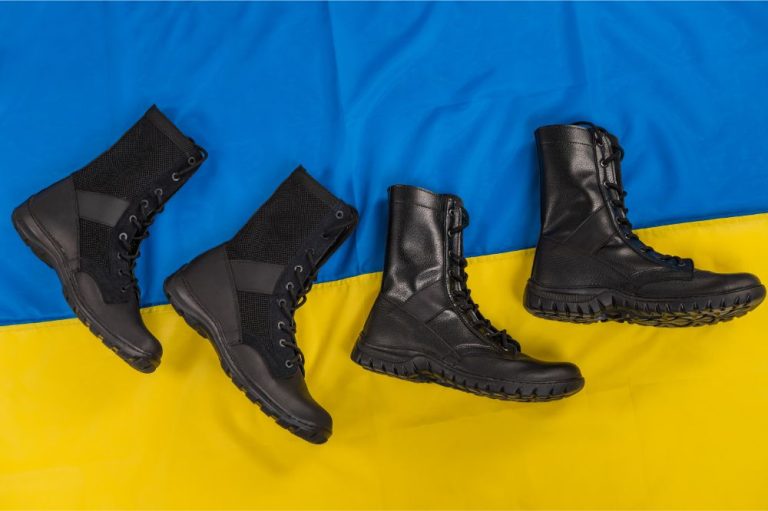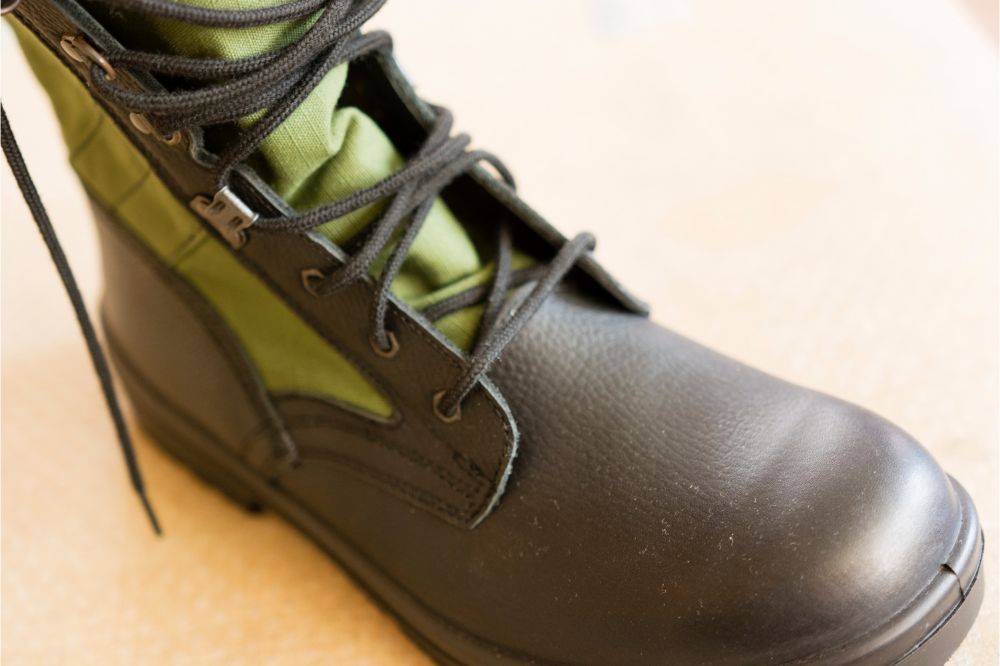Signup for our monthly newsletter and get your FREE "Tactical Gear" Guide
Are Tactical Boots Waterproof?
- Home
- Tactical Boots Advice
- Are Tactical Boots Waterproof

This site contains affiliate links to products. We may receive a commission for purchases made through these links.
Waterproof footwear should serve you well if you live in wet and marshy areas, but how about when you’re from a hot and dry region?
Regardless of the climate in your area, waterproofing will always be an essential feature in your pair of work boots.
More and more people gravitate toward tactical boots more than any other type of boots these days. As such, the need for waterproof models has become overwhelming.
In fact, it’s the reason waterproof tactical boots are popping out everywhere.
Are tactical boots waterproof? Can they keep water out 100%? Let’s find out.
Table of Contents
Tactical Boots’ Waterproof Feature
Are Tactical Boots Waterproof?
What Makes Tactical Boots Waterproof?
Tactical Boots’ Waterproof Feature
Many love the look and functionality of tactical boots, and we totally get it!
This fashion staple can be great for both men and women trying to look like cool military personnel or their favorite action stars in their everyday lives.
While waterproofing is a coveted feature in tactical boots for military and civil use, many still doubt its reliability.
That’s because despite what you see in the ad, there is still a chance water can seep through to your feet.
Technically, waterproof doesn’t necessarily mean WATER-PROOF.
It’s more a combination of water repellency, resistance, and the shoes’ waterproof lining.
That should be enough to keep water out in many everyday circumstances, but it still does not guarantee 100% waterproofing.
This holds true even with really good models.
Generally, waterproofing means boots can keep your feet warm and dry in up to three inches of water.
Deeper than that, and the waterproofing feature might not be able to hold up.
Are Tactical Boots Waterproof?
So, are tactical boots waterproof? A lot of them are, but some are not.
In this group, some models are water-resistant, while others are completely powerless at keeping water out.
Where waterproofing is concerned, jungle and wet weather tactical boots are at the top, while desert boots—for obvious reasons—are somewhere at the bottom.
Tactical boots meant for cold, wet regions are often designed differently, especially when it comes to how they deal with water.
Since they encounter it on a daily basis, some of their parts have to be built differently.
Waterproof tactical boots usually have eyelet holes and a waterproof lining.
Their outsoles and upper construction also tend to be different compared with their non-waterproof counterparts.

What Makes Tactical Boots Waterproof?
You will know that a pair of tactical boots is waterproof if its following features are designed this way:
The Outer Boot
The outer layer is what first makes contact with water, so it has to be designed to either keep water out or resist it to some degree.
Tactical boots are generally made of genuine leather, synthetic fabrics, or synthetic leather.
Waterproof models are usually made of genuine or synthetic leather, as these materials possess natural qualities that give footwear decent waterproofing.
They are not completely resistant to water penetration, but they are capable of keeping water from entering the shoe to some degree.
Waterproof Coat
Many tactical boots are designed with a waterproof coat to help prevent water from seeping into the boot.
It is a must-have feature for any pair of waterproof boots and adds to its water resistance.
If your job constantly exposes you to a wet environment, like a car washer or a fisherman, your boots’ waterproof coat feature is the main reason your feet stay dry.
Then again, if you work in wet environments a lot of the time, you will want to have your boots recoated every couple of months to keep this feature effective.
Waterproof Construction
Many tactical boots are manufactured by stitching the different sections of the footwear together and adhering them to the sole.
While this results in a great-looking pair of boots and can keep water out to some degree, it leaves microscopic gaps between sections for water to seep into.
Some brands use waterproof glue to ensure there are no spaces or holes between sections. Others sew parts together using waterproof threads.
Waterproof Lining
To maximize waterproofing, some brands design their boots with a waterproof lining on top coating and construction.
Take note that you may only get this particular feature from an expensive, high-quality pair of tactical boots.
That said, this is what makes a pair of tactical boots’ waterproofing as good as it gets.
Currently, the Gore-Tex membrane is one of the best and most effective waterproof lining materials for tactical boots.
Boot Upper
Have you ever noticed that the upper of many tactical boots is made of nylon material? That’s because nylon is lightweight and 100% water resistant.
Not to mention, sewing nylon fabrics minimizes the tiny gaps that often form when stitching together leather boot parts.
Waterproof Tactical Boots: Pros and Cons
A tactical boot’s waterproof feature is great for a lot of things, including your comfort and the boot’s longevity.
However, waterproofing can also take away from some other valuable features. Let’s discuss this further in this section.
What makes waterproofing on tactical boots great?
Here are the top reasons you should aim for a waterproof pair of tactical boots:
It protects the boots from damage and maintains their look over time.
- Prevents long-term damage to the boots’ internal components
- Increases the lifespan of boots
- Maintains the boots’ aesthetics over time
- Prevents thread breakage and resewing as a result
- Adds another layer for supporting intense physical activities
- Boots dry faster and more easily
- Maintains functioning in wet, rough terrains
- Makes the boots more slip resistant
It keeps the feet comfortable and dry.
- Prevents feet from getting damp and affecting our comfort and moods as a result
- Because it helps prevent bad moods, you can work with more efficiency
- Constantly wet feet are linked to numerous health issues, especially in low-temperature regions
- Waterproof boots are more snow-proof to help keep feet warm and dry in cold weather
- Prevents poor blood circulation as a result of cold feet
- Prevents limb numbness, which can lead to diseases of the bones and joints
It helps prevent blisters.
- Your feet don’t rub against moist or soggy fabric or leather, which tends to be stiffer and causes more friction against your feet
- No worrying about the constant rubbing of your feet against wet leather, which can cause painful blisters that make you less efficient at what you do
- No pair of tactical boots is ever 100% waterproof, but picking a waterproof pair ensures you won’t be as prone to blisters, even if the inside of your boots gets wet
- May be worn for days or weeks at a time without causing blisters
It’s suitable for different professions.
- Be more functional when working in humid conditions or wet surfaces. This is a great pair of boots for fishermen, engineers, trekkers, car washers, members of the coast guard, and the like.
- Especially ideal for hunters and military personnel whose jobs require them to be efficient in all kinds of environments
- Best for regions that get a lot of rain
- Great for different types of terrains, such as plains, mountains, marshlands, swamplands, and forests
What makes waterproofing on tactical boots not so great?
While waterproofing can make your tactical boots better in many ways, you need to pay the price to enjoy such benefits.
It takes away from the boots’ breathability.
- That’s because structures that let air in and out tend to also let other elements in, such as water. As such, many models of these boots aren’t breathable.
- Even the Gore-Tex membrane, known for its waterproofing and breathability, cannot completely prevent water from seeping through the lining and into the boots.
- Not ideal for civil use in hot or warm seasons because your feet get sweaty from the lack of airflow inside the boots.
- Plus, moisture from the inside of your boots caused by sweat has no way of drying faster, causing you discomfort and making you less efficient as a result.
It can be quite expensive
- Generally, tactical boots are sturdier, longer-lasting, and more capable in emergencies than regular footwear.
- However, that also tends to mean they can be a lot more expensive than their regular counterparts.
Weigh the pros and cons carefully.
If your job requires you to be present in the field more than it doesn’t and regularly exposes you to wet environments, the answer should be obvious.
No price is too high, especially if it means your safety.
When To Get and Not To Get Waterproof Tactical Boots
The waterproof feature is a great addition overall. It has the ability to boost both the comfort and longevity of a pair of tactical boots.
That said, waterproof tactical boots are not suitable for all users.
If you are a civilian in a hot or dry region, for instance, you may not experience the full impact of their benefits.
In fact, they may bring more problems than solutions.
If breathability is more important to you than waterproofing, these boots may not deliver.
That said, if the opposite is true, and your work regularly exposes you to wet environments, these boots can be an invaluable addition to your gear.
Not only do they help you work more comfortably and efficiently, but they also help protect your feet and the rest of you from the hazards of your workplace.
